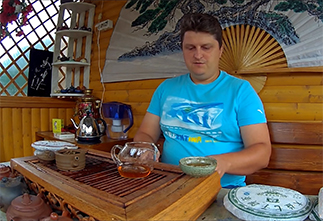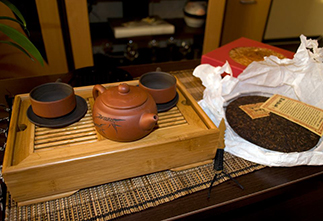Shu Puer "Yin Gui" (音歸) 2020 from Xing Yang Cha: a clear base for every day
This tea is a 2020 harvest shu pu'er (熟普洱, Shú pǔ'ěr) produced by the Xing Yang Cha (興样茶, Xìng yàng chá) factory under the intriguing name "Yin Gui" (音歸, Yīn guī). The tea comes from the Yunnan province and is presented in the classic form of a 357-gram cake Bing Cha (饼茶, Bǐng chá). This is a classic, reliable, understandable and functional shu pu'er for every day. The Xing Yang Cha factory produces various types of pu'er, and "Yin Gui" is one of their products in the moderately aged shu pu'er category.
The name "Yin Gui" (音歸, Yīn guī ) : the return of sound
The name "Yīn Guī" can be translated from Chinese as "Return of Sound" or "Return of Music". This is a rather poetic name that does not directly indicate the taste, but hints at some harmonious or returning aftertaste sensation from the tea.
Vintage 2020: youth and stability
The tea was made from 2020 raw materials. At the moment, it is about 4.5 years old - this is the age when shu puer has already managed to soften significantly after the fermentation process ("vodui"), but has not yet acquired the deep notes of many years of aging. This age often provides a good balance between the formed taste and the lingering energy of the tea, which meets the expectations of a "clear base".
Taste and aroma: a clear base with character
Yin Gui is a clear working shu. The so-called base. This means that you can expect a classic, recognizable shu puer profile from it, without extreme or unusual notes. However, it has its own characteristics:
- Pleasant Round Bitterness: Unlike the sharp bitterness of young sheng, there is a pleasant and round bitterness that adds structure and balance to the taste.
- Light tobacco aroma: A light tobacco note in the aroma is a fairly common note for shu pu-erhs, adding brutality and warmth to the profile.
- Base: As a base shu, it has the standard woody, earthy and nutty notes characteristic of this type of tea.
Work shoes for every day
This tea is ideal for regular consumption, especially as an accompaniment to work or study. It is a cake that will not sit on the shelf for long, due to the fact that it will be regularly consumed while performing some tasks. Its clear profile and good value for money make it a reliable choice for everyday tea drinking when you just need a good, functional shu pu-erh.
Brewing recommendations
Standard method for shu puer:
- Preparation: Chip off 5-8 grams of tea from the pancake.
- Rinsing: Rinse the tea 1-2 times with boiling water (95-100°C), quickly draining the water.
- Brewing: Use boiling water. Start with short infusions (10-15 seconds), gradually increasing the time for subsequent infusions. Given its "working" nature, it is also well suited for steeping in a thermos or mug.
Shu Pu-erh Yin Gui 2020 from Xing Yang Cha is a reliable, understandable and functional representative of its class. It does not seek to surprise with exotic notes, but offers a stable basic profile of shu pu-erh with interesting accents in the form of a pleasant rounded bitterness and light tobacco in the aroma. This is an ideal working tea for daily use, which will be appropriate during work, study or just to enjoy a cup of good shu pu-erh without unnecessary complications.
|
Name in Chinese
|
音歸 |
|
Pinyin
|
Yīn guī |
|
Country
|
China |
|
Provinces
|
Yunnan (云南) |
|
Manufacturer
|
Син Ян Ча (興样茶) |
|
Raw material production date
|
20.09.2020 |
|
Year of pressing
|
2020 |
|
Pressing form
|
Bing Cha (Cake Tea) |
|
Declared weight, g
|
357 |
|
Size
|
20x20x2 |
|
Length, cm
|
20 |
|
Width, cm
|
20 |
- Комментарии
- Вконтакте
Pu-erh is one of the most unique types of tea, which only gets better with age. Many people, when they first encounter this tea, wondered: why is pu-erh more often found in pressed form (cakes, bricks, tochas), and not in loose form? The reasons for this are related to both history and the practical aspects of storing and fermenting tea. Despite modern technologies that allow the production of loose pu-erh, the shape of pressed cakes remains unchanged. And pu-erh is more often found on sale in pressed form, for example, in the form of cakes or bricks, and loose pu-erh is less common. We will talk about the reasons for pressing pu-erh into cakes in this article.
Puer is a unique Chinese tea that is distinguished by its depth of taste, complexity of aromas and versatility of aftertaste. Its taste characteristics are formed under the influence of many factors, from growing conditions to the brewing method. Let's look at the main ones.
The question often arises: how to brew puerh correctly? Sometimes the phrase "to get high" is added to it. Moreover, everyone has their own understanding of this phrase. Some mean vigor, and some - intoxication. So how to brew puerh tea correctly? Let's consider several options.
Traveling through the tea mountains, we found ourselves in another land of blue roofs - the village of Zhongcai, which is located in the Menghai district of Yunnan province. According to tradition, we were shown another local tea tree, which, according to the Chinese, is at least a million years old :) The village is very authentic, not designed for tourists, there are many wild pu-erhs there and, of course, we were warmly received. They treated us to local cuisine and tea. We also asked the residents about the prices of tea and how they have changed in recent years.
The tea ceremony occupies a special place in the centuries-old Eastern tradition. And although the essence of this phenomenon remains constant, the nature and external manifestations of the tea ceremony in different nations have their own national characteristics. In each Chinese province, the tea ceremony and the tea used in it are varied: for example, residents of the southern provinces prefer green tea, and residents of the northern provinces - red tea, in Fujian province they more often use Oolong tea, and in Yunnan province Puer tea is widely known.
























































































